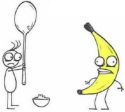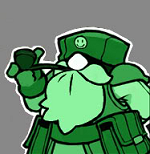|
Dr. Stab posted:Trains are 100% an indulgence. You don't need to engage with them except that you like making train systems. Ummm, that seems very wrong. I am mining out 3 smallish iron ore patches that are kilometers away and its not near enough throughput, that's what prompted my post. Using belts for it is out of the question as it would take tens of thousands of blue belts minimum to be even close to the throughput I would need. Dr. Stab posted:That said, if you want trains to bring resources to your base: Build a station next to your mine and a station next to your smelters and draw a loop that connects them. Set the train to wait at the mine until full and wait at the smelter until empty. That's all you really need. You can hook up more mines to the loop and assign one train to each mine and that will get your ore to your base. You could make a fancy train dispatch system, or you could just use slightly more trains and a much simpler system. Yeah, this is basically what I'm doing now. The problem is it doesn't seems scaleable - I have separate stations for each material type and they're going painfully slow and backing up like crazy. I guess I can try and figure out how to make usable stackers behind each station so that they don't just back up for miles - I've never built one of those but it's probably the next step. concise posted:Trains are almost a necessity if you want to scale production past a 1-2 science per second. Yeah, this is where I'm at. I'm at probably 2-4 science per second right now and I'm extremely starved for iron, used up my starter patches and the closest (small) patches long ago.
|
|
|
|

|
| # ? Jun 11, 2024 09:56 |
|
Taffer posted:Yeah, this is basically what I'm doing now. The problem is it doesn't seems scaleable - I have separate stations for each material type and they're going painfully slow and backing up like crazy. I guess I can try and figure out how to make usable stackers behind each station so that they don't just back up for miles - I've never built one of those but it's probably the next step. The secret to loading Factorio trains quickly is just like real life: it's a function of having everything ready at the station to load, and moving it from station to train at the highest possible speed from as many places as possible. This isn't easy, but you're playing Factorio. At your source stations, have chests set up with stack inserters between chests and where the cargo wagon stops, and wire the chests to the station so the station doesn't enable until you have a full train load. The more inserters you have per wagon, the fewer stacks each inserter has to move. More wagons means more capacity, and potentially more time to make the station ready to load a train, but that also means you can service more sources and sinks with the same number of trains. Sink stations should be the reverse of source stations: as many stack inserters as possible, chests wired up so the station doesn't enable until there's room in the chests for a full train load. If you give all the sources and sinks for the same resource with the same train size the same name (i.e. multiple stations named "iron ore sink" or "plastic source 4") your trains will pathfind to an enabled one automatically, with the caveat that they'll prefer closer ones. Don't put a bunch of extra space at stations for trains to queue up, and always make sure there's an escape hatch so a queued one can nope out.
|
|
|
|
Taffer posted:What's the secret to trains in this game? I have a total blast in this game, but by the time I get to the point where I need more than a handful of mining outposts my drive just fizzles out because the logistics of trains are such a pain in the rear end. There seem to be so many ways to do trains and they all seem to be really frustrating. How do you all do it? I've never made it to megabase levels, so I just throw out a few outposts and have them come back to an unloading station by type of material. I use a blueprint book full of various intersections/etc with FARL for the long distances in between.
|
|
|
|
If you're only building a small base, train logistics are easy. Make each siding long enough to fit 2-3 trains, never put more than 2-3 trains on that resource. Once you scale past that, stock train logistics are a giant pain in the rear end.
|
|
|
|
Taffer posted:What's the secret to trains in this game? I have a total blast in this game, but by the time I get to the point where I need more than a handful of mining outposts my drive just fizzles out because the logistics of trains are such a pain in the rear end. There seem to be so many ways to do trains and they all seem to be really frustrating. How do you all do it? Taffer posted:Yeah, this is basically what I'm doing now. The problem is it doesn't seems scaleable - I have separate stations for each material type and they're going painfully slow and backing up like crazy. I guess I can try and figure out how to make usable stackers behind each station so that they don't just back up for miles - I've never built one of those but it's probably the next step. So I'm going to discuss the paradigm I typically use, which can be simplified as "producers and consumers". There are any number of ways to approach the problem of delivering resources to the place they're used, but this one works with the general way I end up designing my base. I use a pretty standard main bus design for my base, where usable resources (iron, copper, steel, plastic, circuits, etc) are transported along a linear path and then I have manufacturing sections branch off the main bus, splitting resources off the main bus lines as needed. This simplifies the general basic design for resource delivery - all usable resources end up on the main bus. As far as my assemblers are concerned, the main bus is the "producer" of resources and they are the consumer. However, as far as my train network is concerned, the outposts are the "producers" of resources and the main bus is the "consumer". ---- Here I'll describe the path of adding a new iron patch and connecting it to the network. Let's take an iron mining outpost as an example A new iron patch is located. The rail network needs to be extended to reach the new iron patch. I use a two-lane system. - An intersection is constructed off the existing rail network and signaled, to accommodate incoming and outgoing trains. - The rail network is extended out near the new iron patch to connect to the station. An outpost needs to be constructed at the destination to handle loading of iron ore. Once I've decided where I want the outpost to be, I'll construct the train portion of the outpost, which consists of a few parts: - The off-ramp, where incoming empty trains leave the main rail line to head to the station - A holding area or "parking lot", where multiple incoming empty trains can sit waiting for the station to be free without obstructing rail traffic elsewhere. - From the parking lot, the rail lines follow a one-way route that leads "out", as in the path returns to the on-ramp that rejoins the rail network. This includes branches to one (or more) loading stations where trains will actually be loaded from the outpost, before merging back on to the on-ramp and heading back out to the rail network for delivery. - The loading station is constructed, based on whatever size train you are using. Typically, I load from both sides, with incoming belts of material delivering to stack inserters which load into chests to buffer for a train's arrival, and then stack inserters load the train directly from chests. Since I use 4 cargo wagons, this means there are 8 total belts going to the station. I'll start putting down the belts, working backwards from the station, until I can line up all 8 belts together neatly, and place down an 8-lane belt balancer. - - Any incoming material will feed into this 8-lane balancer and spread it evenly across all 4 loading wagons. I want to avoid a scenario where my mining outputs are unbalanced. - Now circuits get involved. I connect all of the loading chests together so that I can get a combined count of how much ore is actually in the chests as a buffer. - - Since each cargo wagon holds 2000 ore, and I use trains with 4 wagons, I want to know when all of the chests combined reach at least 8000 ore. - Now I connect the train stop to the network, using the circuit network to set conditions. I only want the station to be enabled so long as there is at least 8000 ore between all of the chests - - If there isn't enough ore to fill at least one train, then I want the station to be disabled. This stops trains from coming to the station and waiting. - Once the train stop is configured, I go ahead and give it the appropriate name. Since this is an iron mining outpost, we'll call it "Ore Loading - Iron". - - Note that if I have any other iron mining outposts, their train stops will also have the same name. Any trains that are scheduled to make stops at "Ore Loading - Iron" will choose the nearest available station with that name. Since the stations are only enabled when they have enough resources to load a full train, I don't have to worry about setting up dedicated trains for each outpost. - - - Instead, I have one type of train with a route that looks something like this: Go to "Ore Loading - Iron" and wait until full. Go to "Ore Delivery - Iron" and wait until empty. Go to "Main Parking Lot", and wait 15 seconds. More on this in a moment - Now that the rail line is set up and the station is build and configured, I'll go ahead and actually build the mining portion of the outpost itself - putting down the miners and belts. I don't have to worry too much about this part; all of the miners output into the giant 8-way belt balancer I've already put down, which will more or less evenly distribute the output of the miners between the chests used to load into the train. - At this point, the outpost is ready and working - existing trains will start routing to the outpost whenever it's sufficiently full. I may or may not add additional trains to the network, depending on whether or not I'm expanding my iron ore production or compensating for an older outpost that's been used up. ---- The mining outpost "produces" iron ore for the train network, which delivers it to destinations that "consume" it. This is only one piece of the puzzle, but you should be able to extrapolate from here more or less what the rest of my design probably looks like. - Mining outposts are set up so they turn on when they have enough buffered material to load a train. - Trains that want to collect iron ore will select the nearest enabled outpost. - Since outposts turn off when they don't have enough material to load a train, this means that as outposts deliver material, they'll turn themselves off and trains will route to other, "ready" outposts instead, ensuring that trains minimize the time they spend waiting to be filled. As far as "consumers" go, there's really one major "consumer" for iron ore - smelting it into iron plates. All iron ore gets delivered to an iron plate outpost, which is similar to the mining outpost - incoming full trains are directed to a station where they are rapidly unloaded onto belts which are balanced and loaded into buffer chests, which are then unloaded and balanced out to feed ore to smelters. The smelters offload plates into a giant belt balancer, which evenly feeds plates into an iron plate loading station, which works just like the iron ore station - plates are loaded into chests, which are connected to the signal network, which turns on the train stop when the buffer chests are filled with at least enough iron plates to completely fill a train. Our smelting outpost is really two outposts in one, with two separate stations that feed into each other - an iron ore "consumer" that feeds an iron plate "producer". The iron plate "producer" station uses its own trains that operate on a separate "iron plates" schedule, that collect "produced" iron plates and feed it to equivalent iron plate "consumer" stations. If you need to expand iron plate "production", you can expand the size of your existing outpost, or construct additional, independent outposts as needed. From a design standpoint, managing resource demand under this paradigm is pretty simplified. Are your "producer" outposts constantly full while your "consumer" outposts don't have enough materials? Build more trains. Are your "producer" outposts not meeting the demand of your "consumers"? Build more "producers". With all mining and smelting outsourced to outputs, your main section of your base can, for example be cleaned up and dedicated to loading materials onto your main bus for manufacture, or set up distributed outpost manufacturing or whatever. The sky's the limit.
|
|
|
|
Trains are fun, and vastly improve throughput of resources. I would wholeheartedly suggest making a dedicated railway network: two lanes for both directions, roundabouts every so often. I've had a few megabases, and the way I do it is making a huge central hub in one of the cardinal directions away from my base, a screen or two away (to provide ample space for scaling up). I then have an obscene layby / waiting area for trains to pull up into whilst they wait for one of the central hub stations to become available. This stops standstill traffic, and allows other trains carrying other cargo to access their respective stations without needing to wait for the 5th iron ore train to pull into it's station first. I make it so the layby / waiting area is on the main network, so if a train decides to go somewhere else, it can just pull onto the track and go, without needing to funnel into the central hub and potentially cause backups. Then just set it up so you have inserters on both sides of the wagon loading / unloading. I've never used wires to automate train stations, but I definitely see the benefit in it. Trains could just chill out in the layby, then zip out when a station opens up to load and deliver to the base. Use belt magic to evenly split output of resources so each belt is fully loaded and evenly distributed, and you can have a train loaded in about one minute or less. It's great. It's super fun setting up, works without a hitch, and will have you drowning in materials. I had disgusting 16-lane wide highways just full of iron ore / copper ore etc. and it was beautiful to see. Qubee fucked around with this message at 00:04 on Sep 8, 2019 |
|
|
|
Taffer posted:Ummm, that seems very wrong. I am mining out 3 smallish iron ore patches that are kilometers away and its not near enough throughput, that's what prompted my post. Using belts for it is out of the question as it would take tens of thousands of blue belts minimum to be even close to the throughput I would need. If you're building a giant factory, by all means go for rail, but I was under the impression that you were just reaching out past your initial ore patches and were struggling to beat the game. Trains are not at all necessary to beat the game. Taffer posted:Yeah, this is basically what I'm doing now. The problem is it doesn't seems scaleable - I have separate stations for each material type and they're going painfully slow and backing up like crazy. I guess I can try and figure out how to make usable stackers behind each station so that they don't just back up for miles - I've never built one of those but it's probably the next step. If your trains are backed up, and not gridlocked, then building more fancy ways for them to queue in front of the station will have a marginal to nil effect on throughput. Your system has Miners -> loading station -> train line -> unloading station -> smelters -> the rest of your production line. Every part of that sequence needs to be able to accommodate the throughput you want. Are your trains backed up because you don't have enough unloading stations, or is it because the stations are also backed up? are your smelters backed up as well, or are they starved? Things can get backed up for a bunch of reasons and it's good to identify which reasons apply. Mostly likely, you need to build more unloading stations, but I haven't seen your factory so I don't know. You say that the stations are going painfully slow? Why? 4 science per second requires ~8 blue belts of iron, which is around 800 unupgraded miners, 100 fully beaconed smelters (800 unbeaconed) and 2-3 unloading stations, depending on your setup.
|
|
|
|
For me this game is a train game. I build stuff so that trains have a reason to move stuff. Logistics train network is a super cool mod, but I got comfortable with trains for about 300 hours before I found it. I don't think anyone should wait that long, but it's probably best to fiddle with them for awhile before you install it. Just start building stations and see what develops. Only thing I'd say to keep in mind off the bat is (1) build 2 lanes if you're going any kind of distance, and (2) if you're building a station, don't build it on the main highway, build a spur off to the side.
|
|
|
|
LTN makes this the best train game on the drat market. Here are some other train tips: try to keep a standard left side or right side drive lane for your trains. your network can be hard to reason about if your polarities shift. If you're not using LTN, your train will wind functioning as a buffer for stuff that isn't being consumed rapidly. that's ok, as long as your loaders are able to prep to load easily. do not stand on the tracks. chain signals ahead of branching paths, regular signals everywhere else. Pick a maximum length lenght of train you're going to have and lay signals roughly every x spaces.
|
|
|
|
If your trains are slow you need to do better with station and signal placement. Also not accidentally making junctions that lock the network when trains stop in awkward locations.
|
|
|
|
|
It took me a little too long to realise you can name multiple train stations one thing, for example 'copper pickup' and 'copper dropoff', so you don't need a 10 station long todo list for each train. Trains can be really messy if you've not planned well enough, i've got a 150 hour save that's had a major train highway splitting the oil and power area from the main production zone for about 100 of those, and i think it's a miracle that i've only been flattened once or twice when crossing it. I've started a new game on rail world just so i can get a fresh start without fighting bugs for 20 hours, and really get a grip on good practices for stations and unloading and stuff. I need to do some experimentation with how i unload to smelters, and how/if i can balance large amounts (16+ blue belts) of copper/iron plates since belting from stations to smelting can leave certain factory parts running dry when there's only distant mining stations active. I also haven't tried smelting at the mine yet but i'm starting to think a lot about it just to make the main copper and iron stations a sane size. Either way i friggin' love how modular and extensible a good train network is, going out and slapping down a new station and getting trains queueing up before you've even left feels great. edit: i guess i should smelt in big batches off-site and train the basic products into my base now huh. gently caress that's gonna take a while to arrange. Wallrod fucked around with this message at 02:20 on Sep 8, 2019 |
|
|
|
Olesh posted::snip: great train info Thank you (and others), this is really helpful. I think I was starting to move in this direction but it's helpful to have it all laid out like this. I'm finally starting to get how chain signals are supposed to work, and I just built my first successful stacker from scratch behind my iron unloader so I can actually hold a few trains there in a queue without a big line of trains blocking my main routes. I'm trying to start building standardized outposts too, so that the trains can all be the same size and share stations (my first couple outposts were just sized according to what I had available, which in retrospect was a mistake). This way I can have a bunch of outposts with a shared name like you describe. My next step is to try and incorporate the station disabling like you're describing - that sounds really really clever and seems to be exactly what I need to properly utilize my rail network. Thankfully I have played a couple games with people who knew how to use trains so I knew to make proper two-way rails from the very start. I was using a FARL at the beginning, but despite being fast that mod is a huge PITA to configure so I've gone back to just laying down tracks with blueprints - I'm trying to build up a little collection of blueprints that I've designed, instead of trying to build everything from scratch. Doing signals properly at every intersection by hand is... not fun. So in your setup, an iron train is always an iron train? When demands shift do you manually add/remove trains from certain item types to something else? Thanks again - I'll probably be back more with lots of questions once I get a chance to play around with this some more.
|
|
|
|
Taffer posted:So in your setup, an iron train is always an iron train? When demands shift do you manually add/remove trains from certain item types to something else? As far as re-purposing trains goes.... the general assumption I work with is that resource consumption will always go up over time, so I'll always need to add trains, and so there will never be a reason to reduce throughput. If the existing count of, say, iron ore trains are sitting around inactive, it's one of two things. If the trains are sitting around empty, it's because I'm not producing enough iron ore - maybe I expanded manufacturing and now have more resource demands, maybe an outpost dried up, whatever. In this case, I need more mining outposts, not fewer trains. If the trains are sitting around full, it's because I'm not consuming iron ore and producing iron plates fast enough - either my smelters are producing more iron then I need at the moment, or I need more smelters. Getting rid of trains wouldn't solve either of these problems. Your number of trains is your throughput, ultimately. Once you've got a decent train system going, adding trains improves throughput, removing trains reduces it. Something to be mindful of, however - hypothetically, let's say that you have 10 trains empty and waiting for one of your outposts to be ready. One of your outposts fills up to a train's worth of ore and your circuit switch there enables the train stop. What will happen is that ALL TEN of your trains will start heading over to that outpost. When the first one reaches the outpost, the rest of the trains will still be en route. If there's another open outpost by that time, the remaining 9 trains (plus any new trains that unloaded and returned to the parking lot) will all want to start heading over there. Your rail infrastructure needs to be able to handle this by ensuring no matter where a train decides to change its mind, there's always a way for them to get there without going through a station that might shut itself down. Make sure there's always a way for queued up trains to leave outposts without passing through any train stops, and make sure trains can always turn around without necessarily having to go through an outpost.
|
|
|
|
Impermanent posted:LTN makes this the best train game on the drat market. Seconding this. I went back to vanilla to knock out the last few achievements I had left, and LTN was the mod that I missed the most, by far.
|
|
|
|
Been playing local multiplayer and need to settle a disagreement. Are processing units "blue circuits" or "purple circuits" ?
|
|
|
|
ShadowHawk posted:Been playing local multiplayer and need to settle a disagreement. Early game they're "blue chips" and late game they're "purple circuits." I doubt this helps you.
|
|
|
|
People who call them chips are the ones that really need to be persecuted.
|
|
|
|
they're salsa verde, nacho cheese, and cool ranch doritos.
|
|
|
|
They’re blue chips and you’ll take that from my cold polluted hands
|
|
|
|
|
Blue circuits-on-chip Edit: the only thing worse than calling them chips is using the word "petroleum" alone to mean "petroleum gas"
|
|
|
|
M_Gargantua posted:They’re blue chips and you’ll take that from my cold polluted hands Amen, syllables are expensive. GotLag posted:Blue circuits-on-chip “Petrogas,” “light,” and “heavy.”
|
|
|
|
"gas"
|
|
|
|
Greens, Reds and Blues.Two word descriptions are for casuals.
|
|
|
|
I'd have called 'em chazwazzas.
|
|
|
|
Using Side Inserters to shrink a Katherine of Sky-style mall by 1/3:
|
|
|
|
post blueprint please
|
|
|
|
When I do my napkin planning they're noted as C1, C2, and C3.
|
|
|
|
Katherine of Sky mall shortened by a third through application of side inserters: Blueprint string
|
|
|
|
Anyone got any good Krastorio blueprints? I found a useful early game book and a nuclear reactor array on the prints website, but not much else. This run has been a blast, my base is a terrible mess of spaghetti that sort of works! I'm choking at purple science, making the modules has evaporated my scant output of red circuits. I'm going to have to scale up pretty soon to mass-produce, but I've been procrastinating by building more outpost mines. I'm using Bob's Enemies, but they really can't compete with my laser walls. Evolution is at about .76.
|
|
|
|
No krastorio blueprints, but I can say that my method of having a main bus, a secondary one for all the added silicon and associated chips, and then a couple smaller ones to transport necessary ingredients between them is working out. The only reason I wound up doing that is because, going in blind, I had no idea which things would be useful to put on a single bus.
|
|
|
|
|
The Industrial Revolution mod in today's FFF looks pretty great -- I can't wait to try it out. e: vvvv you're right, it was last week's ZekeNY fucked around with this message at 01:59 on Sep 12, 2019 |
|
|
|
Last weeks FFF you mean. I've been playing it and it's rather nice. Don't add anything other than QoL mods though or you spoil the feel of it. The author has been busy fixing things and adding polish since the beta release.
|
|
|
|
I picked up IndRev after reading the FFF too. It's a huge step up in complexity and it makes the burner phase uncomfortably long, but all in all, I enjoy it because it's making me have to re-learn and in most cases, invent new solutions to production problems. After about 5 hours, I'm just now getting copper and tin on a bus and getting inserters, belts and some red science automated. Now I need to dive deep into bronze to get ore crushers running so I can make glass for green science. Edit: Got some work done tonight and got a rudimentary as gently caress red and green science setup to get me to iron and power. 
Royal W fucked around with this message at 05:11 on Sep 12, 2019 |
|
|
|
I haven't played since like, .14 and these modded screenshots are giving me the itch again. I might have Factorio slot in as my lunch break game at work for a bit. I only ever launched a rocket after a very long peaceful game back then, has enough changed that I should play through vanilla again or should I toss in krastorio or Industrial Revolution and just go for it?
|
|
|
|
Science, oil, boiler power generation and a lot of end game items have changed, including a lot of ui, namely blueprints. It's worth another go as vanilla, yes. Maybe with quickstart mod depending on how much you like the burner phase.
|
|
|
|
Not to mention the game has nuclear power now
|
|
|
|
Royal W posted:I picked up IndRev after reading the FFF too. It's a huge step up in complexity and it makes the burner phase uncomfortably long, but all in all, I enjoy it because it's making me have to re-learn and in most cases, invent new solutions to production problems. I decided not to suffer the burner stuff too much and installed Burner Leech. Yeah it's borderline cheaty but if I wanted to play with coal I'd move to Australia. I don't mind the burner phase normally since it has a purpose and is short but IR really drags it out. Leech just cuts down on the number or coal feed lines you need.
|
|
|
|
Burner phase feels like a tutorial and if you like to start over because you made horrible spaghetti it gets old fast. It in no way should be removed from the game, but modding it out is no loss at all running between 4 patches to keep everything running while manually throwing coal in things is pretty tedious the 30th time you do it.
|
|
|
|
Industrial Revolution significantly increases the length of the burner phase.
|
|
|
|

|
| # ? Jun 11, 2024 09:56 |
|
That'll be a hard pass for me, thanks. Burner phase Factorio is the worst part of Factorio.
|
|
|






































